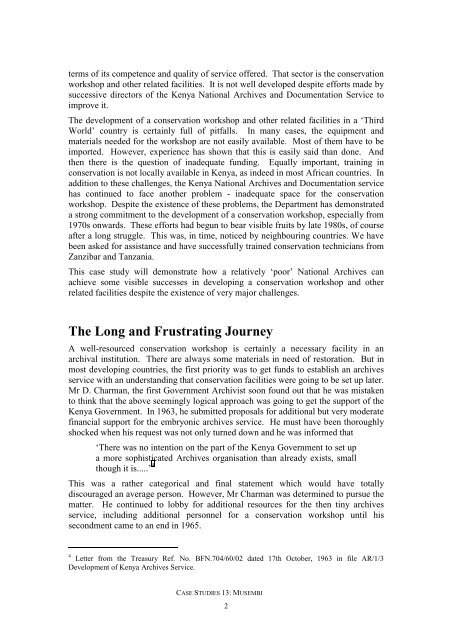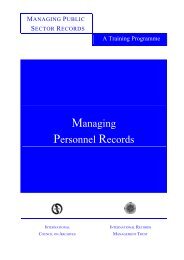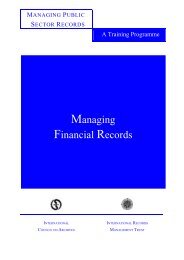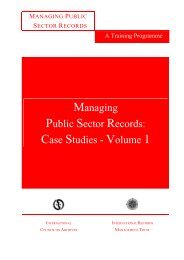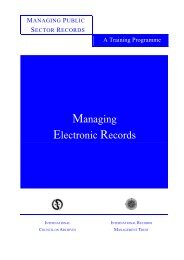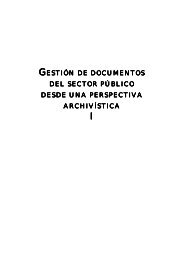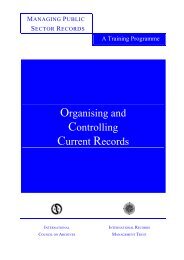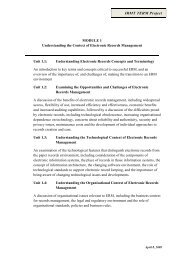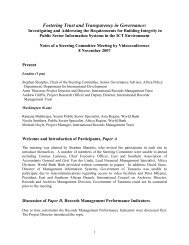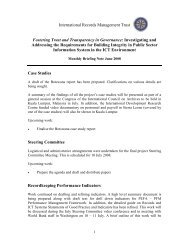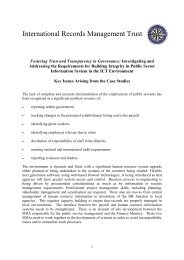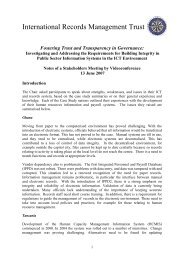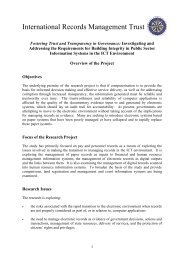managing public sector records: a study programme - International ...
managing public sector records: a study programme - International ...
managing public sector records: a study programme - International ...
Create successful ePaper yourself
Turn your PDF publications into a flip-book with our unique Google optimized e-Paper software.
terms of its competence and quality of service offered. That <strong>sector</strong> is the conservation<br />
workshop and other related facilities. It is not well developed despite efforts made by<br />
successive directors of the Kenya National Archives and Documentation Service to<br />
improve it.<br />
The development of a conservation workshop and other related facilities in a ‘Third<br />
World’ country is certainly full of pitfalls. In many cases, the equipment and<br />
materials needed for the workshop are not easily available. Most of them have to be<br />
imported. However, experience has shown that this is easily said than done. And<br />
then there is the question of inadequate funding. Equally important, training in<br />
conservation is not locally available in Kenya, as indeed in most African countries. In<br />
addition to these challenges, the Kenya National Archives and Documentation service<br />
has continued to face another problem - inadequate space for the conservation<br />
workshop. Despite the existence of these problems, the Department has demonstrated<br />
a strong commitment to the development of a conservation workshop, especially from<br />
1970s onwards. These efforts had begun to bear visible fruits by late 1980s, of course<br />
after a long struggle. This was, in time, noticed by neighbouring countries. We have<br />
been asked for assistance and have successfully trained conservation technicians from<br />
Zanzibar and Tanzania.<br />
This case <strong>study</strong> will demonstrate how a relatively ‘poor’ National Archives can<br />
achieve some visible successes in developing a conservation workshop and other<br />
related facilities despite the existence of very major challenges.<br />
The Long and Frustrating Journey<br />
A well-resourced conservation workshop is certainly a necessary facility in an<br />
archival institution. There are always some materials in need of restoration. But in<br />
most developing countries, the first priority was to get funds to establish an archives<br />
service with an understanding that conservation facilities were going to be set up later.<br />
Mr D. Charman, the first Government Archivist soon found out that he was mistaken<br />
to think that the above seemingly logical approach was going to get the support of the<br />
Kenya Government. In 1963, he submitted proposals for additional but very moderate<br />
financial support for the embryonic archives service. He must have been thoroughly<br />
shocked when his request was not only turned down and he was informed that<br />
‘There was no intention on the part of the Kenya Government to set up<br />
a more sophisticated Archives organisation than already exists, small<br />
though it is.....’ 4<br />
This was a rather categorical and final statement which would have totally<br />
discouraged an average person. However, Mr Charman was determined to pursue the<br />
matter. He continued to lobby for additional resources for the then tiny archives<br />
service, including additional personnel for a conservation workshop until his<br />
secondment came to an end in 1965.<br />
4<br />
Letter from the Treasury Ref. No. BFN.704/60/02 dated 17th October, 1963 in file AR/1/3<br />
Development of Kenya Archives Service.<br />
CASE STUDIES 13: MUSEMBI<br />
2


